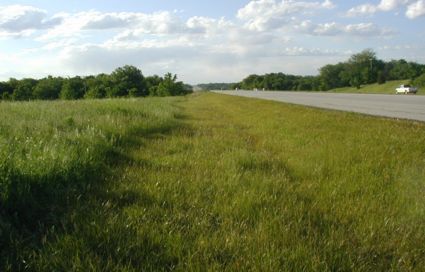Category:821 Herbicides and Roadsides
821.1 Introduction
Pesticides are in a broad category including insecticides, herbicides, algicides miticides and several other chemicals specific to a particular target. Insecticides are chemicals used to control insects.
Herbicides are chemicals designed to control plant growth. When applied at the correct rate, proper time and method, with the proper equipment in suitable weather conditions, herbicides accomplish their manufacturer’s claims. MoDOT recognizes herbicides as a vegetation management tool no different from other tools such as lawn mowers or brush hogs. The word “chemical” often raises a red flag with the public. Some express great concern about applying a synthetic chemical to control a noxious weed yet do not hesitate to have a synthetic chemical injected into their own body to control diseases. Medicine is used to control and prevent disease, herbicides are used to control and prevent vegetation. Both can create disastrous results if not used correctly, but when used correctly, can improve the quality of life.
The purpose of this article is to ensure we use herbicides correctly along Missouri roadsides. MoDOT has guidelines for the planning and ordering of herbicides as well as their storage and inventory control.
| MoDOT's Herbicide Database |
An operator is to determine the target, select the proper herbicide, apply at the correct time, rate and method, use well-maintained equipment and protect himself or herself, other employees, the public and the environment.
821.1.1 Labels are the best source of information
This article takes information from the manufacturer's label on each herbicide and applies it to uses on highway right of way. Operators and their supervisors must read and follow the label.
The rates listed in this article are recommended rates for Missouri roadsides. The label will list a wide range of rates since the manufacturer must consider all parts of the country with a broad range of soil and seasonal conditions. Rates listed here are what have been successfully used in Missouri with the concurrence of the manufacturer's representative.
MoDOT is very concerned about the safe use of herbicides for the operator, the public and the environment, both on and off the right of way. This is why we do not use or purchase restricted use herbicides (or RUP, restricted use products). We encourage employees to attend training sessions offered each year by MoDOT. Employees are also encouraged to obtain and maintain a Certified Public Operators License offered each year in cooperation with MoDOT and the Department of Agriculture.
Safety equipment, commonly referred to as personal protection equipment (PPE), will be furnished to mix and apply herbicides. This equipment must be used when required. Unnecessary use of safety equipment is discouraged due to the possibility of heat-related problems.
Protect yourself from splashes or spills during mixing. To reduce exposure to herbicides, use common sense and personal hygiene practices such as washing hands, arms and face frequently, changing clothing daily, not walking in areas treated when still wet and monitoring the wind direction and speed. Wash clothing separately at home and use care when climbing on truck or sprayer because of wet surfaces. It is highly recommended to keep a separate tank of clean water on the spray truck to flush immediately if a spill occurs.
Maintenance purchases herbicides annually for the entire state based on quantity requests submitted in the fall by the districts. When new herbicides are received, the previous year's stock is to be placed where it will be used first. This is referred to as "First In First Out" (FIFO). District maintenance is to be notified if there is an oversupply of one or more herbicides.
Several companies manufacture and sell herbicides such as 2,4-D and glysophate under various names. Operators are to properly identify herbicides before mixing. The label is the best source of information.
821.1.2 Only herbicide combinations permitted by MoDOT are listed in this article
Operators and supervisors should know the visual effects of the herbicides used by MoDOT. Some herbicides such as 2,4-D, may have a noticeable effect within hours under certain weather conditions. Others may take days, weeks, or in the case of Krenite S, as much as nine months for the results to be visible. This article also contains guidelines for special conditions such as those for problem weeds, woody plants, aquatic areas and landscaped areas.
The operator must record the date, route, weather conditions, material sprayed, target and rate of application daily. The standard spray log is included in 821.8 Record Keeping. Record keeping is an important part of all maintenance activities including herbicide application. The Herbicide Database within Lotus Notes, is available to electronically complete spray records. Successful maintenance operations depend on well-maintained equipment. Equipment will be operated by someone who receives training and knows the capabilities and limitations of that equipment. In herbicide application, it is very important that the spray equipment is clean, in good operating order and properly calibrated.
Other topics in this article include plant growth regulators, traffic control for spraying operations, how to report an herbicide spill incident and additives and adjuvants. Forms, a glossary and a listing of products has also been included.
Articles in "821 Herbicides and Roadsides"
The following 25 pages are in this category, out of 25 total.
8
- 821.2 Safety
- 821.3 Public Relations
- 821.4 Pesticides and the Environment
- 821.5 Storage Facilities
- 821.6 Inventory Control and Storage
- 821.7 Planning and Ordering
- 821.8 Record Keeping
- 821.9 Labels and Safety Data Sheets (SDS)
- 821.10 Equipment and Application Methods
- 821.11 Calibration
- 821.12 Mixing and Handling Guidelines
- 821.13 Traffic Control for Spraying Operations
- 821.14 Herbicide Spills Incident Reporting
- 821.15 Forms and Conversions
- 821.16 Total Vegetation Control Treatment
- 821.17 Plant Growth Regulators (PGRs)
- 821.18 Noxious Weeds
- 821.19 Problem Weeds
- 821.20 Woody Plant Control
- 821.21 Aquatic Areas
- 821.22 Weed Control in Landscaped Areas
- 821.23 Additives and Adjuvants
- 821.24 Glossary
- 821.25 Products
- 821.26 Maintenance Planning Guidelines for Chemical Weed Control
